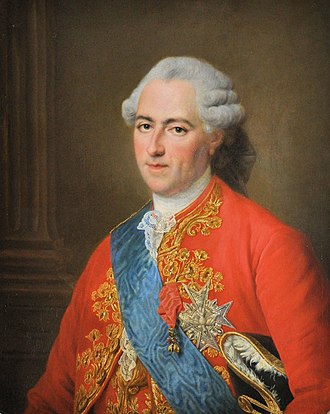World History
Related: About this forumHow Fashion Helped Defeat 18th-Century Anti-Vaxxers
Last edited Wed May 19, 2021, 08:24 PM - Edit history (2)
From *Jan. 21, 2015, 'Pre-COVID.' - In the late 1700s, trend-setters helped normalize the distrusted process of inoculation. Today, a similar movement could encourage parents to vaccinate their kids. - The Atlantic, By Kimberly Chrisman-Campbell. - Ed.

- Marie Antoinette, 1775 by Jean-Baptiste Gautier Dagoty.
It was the perfect storm of disease transmission: a tourist destination packed
with foreign visitors and unvaccinated local residents during a busy season. I'm not talking about last month at Disneyland where a measles outbreak infected more than 50 people in 4 states and 2 countries to date—but the Château de Versailles in April 1774, where smallpox struck more than 50 people, including King Louis XV of France himself. In 18th-cent. Europe, smallpox was a scourge feared by kings and commoners alike. It was highly contagious, grossly disfiguring, and often fatal. But it was also preventable. Smallpox inoculation—which by then was the norm across Asia and the Middle East—was introduced in the West by Lady Mary Wortley Montagu. A smallpox survivor, the English ambassadress to Turkey had witnessed the practice in Constantinople, and upon her return to England in 1718 she became its biggest advocate.
Initially, London society found the practice shocking, but by the end of the 18th century, inoculation had been adopted throughout most of Europe.
France was one of the last holdouts. Though inoculation was common in northern Europe by the early 1770s, it was still regarded with suspicion in France, and with good reason- improperly performed, it could result in infection and even death. Before Edward Jenner developed the first vaccine to combat smallpox in 1798, the practice of inoculation involved injecting a small amount of pus from the lesions of a smallpox sufferer under the skin of a healthy patient—just enough to stimulate the production of antibodies without triggering a full-blown case. (Jenner’s vaccine used cowpox, a mild virus that conferred immunity to its deadly relative; the term "vaccine" is derived from the Latin vacca, meaning cow.) While the likes of Voltaire and Diderot championed inoculation, the conservative French medical establishment resisted the new & risky practice. After a 1762 epidemic was blamed as inoculation gone wrong, it was banned in Europe for 5 years.

- King Louis XV, a year before he d. of smallpox on May 10, 1774.
https://en.wikipedia.org/wiki/Louis_XV
After decades of debate, however, it only took one smallpox death to settle the inoculation question in France once and for all. On May 10, 1774, King Louis XV died after a 2-week illness—an inexorable, excruciating, and very public demise.
We rarely hear about the 10 other courtiers and palace servants who died during the same outbreak. But the new king, Louis XVI, was sufficiently alarmed that he took the controversial step of submitting to inoculation on June 18, 1774. His 2 younger brothers, the Comte de Provence and the Comte d’Artois, were inoculated at the same time—in other words, the entire line of succession. The procedures were a success. Paris milliners commemorated the momentous event with an allegorical headdress dubbed the 'pouf à l’inoculation.' Perched atop a woman’s powdered & pomaded coiffure, it depicted the serpent of Asclepius, representing medicine; a club, representing conquest; a rising sun, representing the king; and a flowering olive branch, symbolizing the peace & joy resulting from the royal inoculation. The pouf—instantly became all the rage..
'White Ribon': A 1785 French fashion plate showed a hat trimmed with a white-spotted "ribbon à l’inoculation," likely referencing pustules of smallpox. When many people still bore scars of la petite vérole, it must have been a powerful & poignant fashion statement.
Crucially, the 'pouf à l’inoculation' wasn't an explicit critique of the 18th-cent. anti-vaxxers, but simply a visible expression of support for inoculation. Instead of picking a fight, it presented inoculation as something normal and harmless. And because the pouf was worn by the fashionable elite of society, it went one step further, making inoculation look not just normal, but also cool. A sense of normalcy is exactly what’s missing from today’s vaccination debate. Already stressed-out new parents are bombarded with the alarmist, emotional accusations of the anti-vaxxers who claim vaccination can cause autism on one hand, and the strident, jargony denials of the medical establishment on the other. We hear a lot about the risks of vaccinations—or, alternatively, the much more serious risks of foregoing them and losing herd immunity as vaccination rates drop below 92%—but little about the vast majority of parents who quietly continue to vaccinate their children according to CDC guidelines, without complications...
Con't,
https://www.theatlantic.com/entertainment/archive/2015/01/how-fashion-defeated-the-18th-century-anti-vaxxers/384696/

- 'The Pouf Aux Sentiments' was one of the most outrageous styles that Marie Antoinette ever wore. It contained the image of anyone or anything a woman felt affection for, such as a canary, friend, or relative and appeared around 1774. As this hairdo was personal & used family relics or souvenirs, women everywhere were crazy to have one created & designed specifically for them..https://www.geriwalton.com/the-french-pouf/